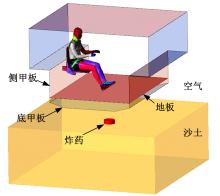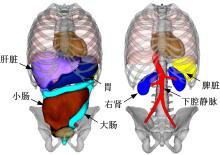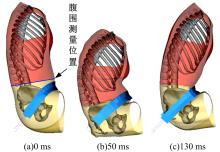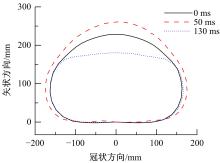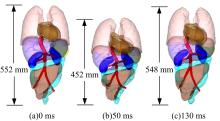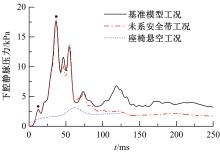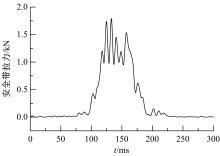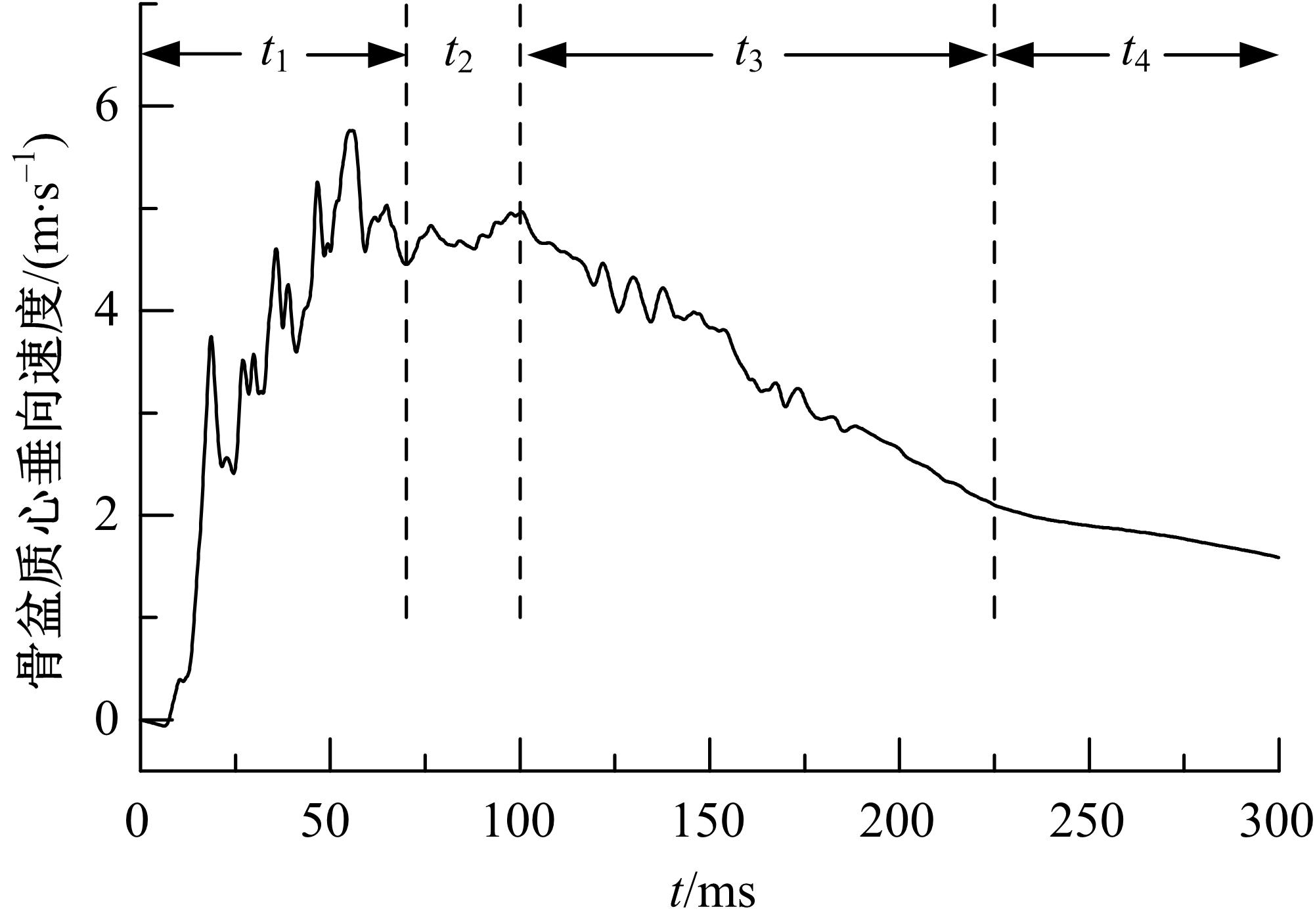Journal of Jilin University(Engineering and Technology Edition) ›› 2021, Vol. 51 ›› Issue (3): 792-798.doi: 10.13229/j.cnki.jdxbgxb20200227
Previous Articles Next Articles
Abdominal injury of vehicle occupant in underbody blast events
Bo WANG1,2( ),Yang-yang HE3,Bing-bing NIE1,Shu-cai XU1,Jin-huan ZHANG1(
),Yang-yang HE3,Bing-bing NIE1,Shu-cai XU1,Jin-huan ZHANG1( )
)
- 1.State Key Laboratory Automotive Satety and Energy,Tsinghua University,Beijing 100084,China
2.China North Vehicle Research Institute,Beijing 100072,China
3.Unit 32184 of the PLA,Beijing 100093,China
CLC Number:
- U461.91
| 1 | Owens B D, Kragh J F, Wenke J C, et al. Combat wounds in operation iraqi freedom and operation enduring freedom[J]. Journal of Trauma-injury Infection and Critical Care, 2008, 64(2):295-299. |
| 2 | Mckay B J, Bir C A. Lower extremity injury criteria for evaluating military vehicle occupant injury in underbelly blast events[J]. Stapp Car Crash Journal, 2009, 53:229-249. |
| 3 | Yoganandan N, Moore J, Arun M W, et al. Dynamic responses of intact post mortem human surrogates from inferior-to-superior loading at the pelvis[J]. Stapp Car Crash Journal, 2014, 58:123-143. |
| 4 | Dong L, Zhu F, Jin X, et al. Blast effect on the lower extremities and its mitigation: a computational study[J]. Journal of the Mechanical Behavior of Biomedical Materials, 2013, 28:111-124. |
| 5 | Lei J Y, Zhu F, Jiang B H, et al. Underbody blast effect on the pelvis and lumbar spine: a computational study[J]. Journal of the Mechanical Behavior of Biomedical Materials, 2018, 79:9-19. |
| 6 | Elhagediab A M, Rouhana S W. Patterns of abdominal injury in frontal automotive crashes[C]∥Proceedings of the 16th International Technical Conference on the Enhanced Safety of Vehicles, Windsor Ontario, Canada, 1998:327-337. |
| 7 | Trollope M L, Stalnaker R L, Mcelhaney J H, et al. The mechanism of injury in blunt abdominal trauma[J]. The Journal of Trauma: Injury, Infection, and Critical Care, 1973, 13(11):962-970. |
| 8 | Hardy W N, Schneider L W, Rouhana S W. Abdominal impact response to rigid-bar, seatbelt, and airbag loading[C]∥SAE Paper, 2001-22-0001. |
| 9 | Ruan J S, Eljawahri R, Barbat S, et al. Biomechanical analysis of human abdominal impact responses and injuries through finite element simulations of a full human body model[C]∥SAE Paper, 2005-22-0016. |
| 10 | Champion H R, Holcomb J B, Young L A. Injuries from explosions: physics, biophysics, pathology, and required research focus[J]. Journal of Trauma, 2009, 66(5):1468-1477. |
| 11 | Ramasamy A, Hill A M, Masouros S, et al. Blast-related fracture patterns: a forensic biomechanical approach[J]. Journal of the Royal Society Interface, 2011, 8(58): 689-698. |
| 12 | AEP-55 VOL 2: 2011. Procedures for evaluating the protection level of armored vehicles—mine threat[S]. |
| 13 | Dey S, Hopperstad O S, Borvik T, et al. Constitutive relation and failure criterion for three structural steels at high strain rates[J/OL]. [2020-03-25]. |
| 14 | Saleh M, Edwards L. Evaluation of soil and fluid structure interaction in blast modelling of the flying plate test[J]. Computers and Structures, 2015, 151:96-114. |
| 15 | Rouhana S W, Lau I V, Ridella S A. Influence of velocity and forced compression on the severity of abdominal injury in blunt, nonpenetrating lateral impact[J]. The Journal of Trauma, 1985, 25(6):490-500. |
| 16 | Lamielle S, Vezin P, Verriest J P, et al. 3D deformation and dynamics of the human cadaver abdomen under seatbelt loading[C]∥SAE Paper, 2008-22-0011. |
| 17 | Miller M A. The biomechanical response of the lower abdomen to belt restraint loading[J]. The Journal of Trauma, 1989, 29(11): 1571-1584. |
| 18 | Snedeker J G, Barbezat M, Niederer P, et al. Strain energy density as a rupture criterion for the kidney: impact tests on porcine organs, finite element simulation, and a baseline comparison between human and porcine tissues[J]. Journal of Biomechanics, 2005, 38(5):993-1001. |
| 19 | Beillas P, Berthet F. Development of simulation based liver and spleen injury risk curves for the GHBMC detailed models[C]∥Proceedings of International Research Council on Biomechanics of Injury Conference, Athens, Greece, 2018:369-381. |
| 20 | Melvin J W, Stalnaker R L, Roberts V L, et al. Impact injury mechanisms in abdominal organs[C]∥Proceedings of the 17th Stapp Car Crash Conference, Oklahoma, USA, 1973:115-126. |
| 21 | Zhang N, Hiroo K, Zhao J. Development of injury criteria for spleen and kidney in side impacts with the full-body human model[J/OL]. [2020-03-25]. |
| 22 | Sparks J L, Bolte J H, Dupaix R B, et al. Using pressure to predict liver injury risk from blunt impact[J]. Stapp Car Crash Journal, 2007, 51:402-432. |
| 23 | Kremer M A, Gustafson H M, Bolte J H, et al. Pressure-based abdominal injury criteria using isolated liver and full-body post-mortem human subject impact tests[C]∥SAE Paper, 2011-22-0012. |
| 24 | Ramachandra R, Kang Y S, Bolte J H, et al. Biomechanical responses of PMHS subjected to abdominal seatbelt loading[J]. Stapp Car Crash Journal, 2016, 60:59-87. |
| 25 | van der Horsr M J, Leerdam P J C. Experimental and numerical analysis of occupant safety in blast mine loading under vehicles[J/OL].[2020-03-26]. |
| 26 | J211/1_201403. Instrumentation for impact test-part1-electronic instrumentation[S]. |
| 27 | Foret-Bruno J Y, Trosseille X, Page Y, et al. Comparison of thoracic injury risk in frontal car crashes for occupant restrained without belt load limiters and those restrained with 6 kN and 4 kN belt load limiters[J]. Stapp Car Crash Journal, 2001, 45:205-224. |
| [1] | Da-feng SONG,Li-li YANG,Xiao-hua ZENG,Xing-qi WANG,Wei-zhi LIANG,Nan-nan YANG. Battery life optimization of hybrid electric vehicle based on driving cycle construction [J]. Journal of Jilin University(Engineering and Technology Edition), 2021, 51(3): 781-791. |
| [2] | Jia-xu ZHANG,Xin-zhi WANG,Jian ZHAO,Zheng-tang SHI. Path planning and discrete sliding mode tracking control for high⁃speed lane changing collision avoidance of vehicle [J]. Journal of Jilin University(Engineering and Technology Edition), 2021, 51(3): 1081-1090. |
| [3] | Wei-da WANG,Yan-jie WU,Jia-lei SHI,Liang LI. Electronic hydraulic brake power system control strategy based on driver intention recognition [J]. Journal of Jilin University(Engineering and Technology Edition), 2021, 51(2): 406-413. |
| [4] | Guo-ying CHEN,Jun YAO,Peng WANG,Qi-kun XIA. Stability control strategy for rear in⁃wheel motor drive vehicle [J]. Journal of Jilin University(Engineering and Technology Edition), 2021, 51(2): 397-405. |
| [5] | Shou-tao LI,Rui WANG,Jing-chun XU,De-jun WANG,Yan-tao TIAN,Ding-li YU. A vehicle collision avoidance control method based on model predictive composite control [J]. Journal of Jilin University(Engineering and Technology Edition), 2021, 51(2): 738-746. |
| [6] | Lu XIONG,Yan-chao WEI,Le-tian GAO. Inertial measurement unit/wheel speed sensor integrated zero-speed detection [J]. Journal of Jilin University(Engineering and Technology Edition), 2021, 51(1): 134-138. |
| [7] | Fang-wu MA,Hong-yu LIANG,Qiang WANG,Yong-feng PU. In-plane dynamic crushing of dual-material structure with negative Poisson′s ratio [J]. Journal of Jilin University(Engineering and Technology Edition), 2021, 51(1): 114-121. |
| [8] | Dao WU,Li-bin ZHANG,Yun-xiang ZHANG,Hong-ying SHAN,Hong-mei SHAN. Visual detection method for vehicle braking time sequence based on slip rate identification [J]. Journal of Jilin University(Engineering and Technology Edition), 2021, 51(1): 206-216. |
| [9] | En-hui ZHANG,Ren HE,Wei-dong SU. Numerical analysis of oil liquid sloshing characteristics in fuel tank with different baffle structures [J]. Journal of Jilin University(Engineering and Technology Edition), 2021, 51(1): 83-95. |
| [10] | Fei GAO,Yang XIAO,Wen-hua ZHANG,Jin-xuan QI,Zi-qiao LI,Xiao-yuan MA. Influence of coupling of elevated temperature and state of charge on mechanical response of Li⁃ion battery cells [J]. Journal of Jilin University(Engineering and Technology Edition), 2020, 50(5): 1574-1583. |
| [11] | Jing LI,Qiu-jun SHI,Liang HONG,Peng LIU. Commercial vehicle ESC neural network sliding mode control based on vehicle state estimation [J]. Journal of Jilin University(Engineering and Technology Edition), 2020, 50(5): 1545-1555. |
| [12] | Chang-qing DU,Xi-liang CAO,Biao HE,Wei-qun REN. Parameters optimization of dual clutch transmission based on hybrid particle swarm optimization [J]. Journal of Jilin University(Engineering and Technology Edition), 2020, 50(5): 1556-1564. |
| [13] | Ji-qing CHEN,Qing-sheng LAN,Feng-chong LAN,Zhao-lin LIU. Trajectory tracking control based on tire force prediction and fitting [J]. Journal of Jilin University(Engineering and Technology Edition), 2020, 50(5): 1565-1573. |
| [14] | Zhi-gang YANG,Ya-jun FAN,Chao XIA,Shi-jun CHU,Xi-zhuang SHAN. Drag reduction of a square⁃back Ahmed model based on bi⁃stable wake [J]. Journal of Jilin University(Engineering and Technology Edition), 2020, 50(5): 1635-1644. |
| [15] | Zhe SHEN,Yi-gang WANG,Zhi-gang YANG,Yin-zhi HE. Drift error correction of unknown sound source in wind tunnel using approximation method [J]. Journal of Jilin University(Engineering and Technology Edition), 2020, 50(5): 1584-1589. |
|
||
